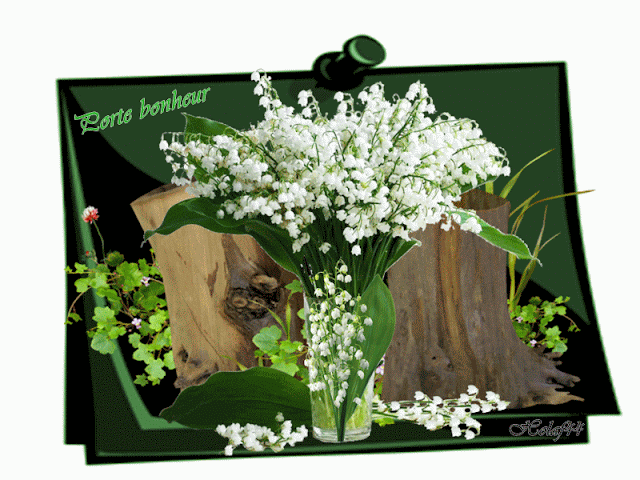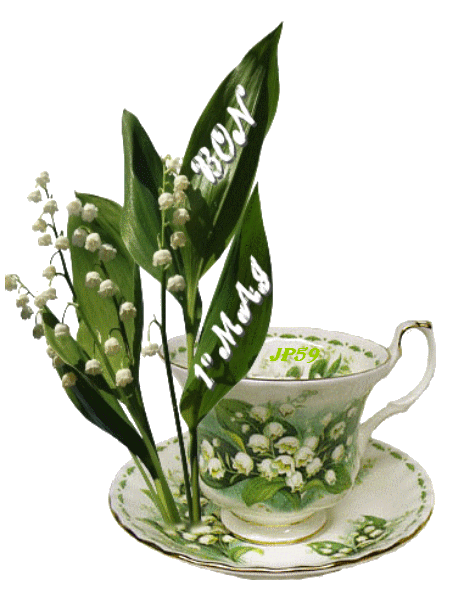A limited native population occurs in Eastern USA (Convallaria majalis var. montana).There is, however, some debate as to the native status of the American variety.
Lily of the valley plants are flowering perennial known for their bell-shaped flowers and rich sweet scent. Lily of the valley is planted en masse in beds and borders. The plants are also naturalized in prairies, fields and on knolls to form large drifts of plants and blooms. They are sold seasonally in the spring as cut flowers and small potted plants. The lily of the valley is associated with a wide variety of meanings from those celebrating tender emotions and holidays to workers rights, a birth month and religious lore.
LEGEND
The flower is also known as Our Lady's tears or Mary's tears from Christian legends that it sprang from the weeping of the Virgin Mary during the crucifixion of Jesus. Other etiologies its coming into being from Eve's tears after she was driven with Adam from the Garden of Edenor from the blood shed by Saint Leonard of Noblac during his battles with a dragon.
The name "lily of the valley" is used in some English translations of the Bible in Song of Songs 2:1, but the Hebrew phrase "shoshannat-ha-amaqim" in the original text (literally "lily of the valleys") doesn't refer to this plant. It's possible, though, that the biblical phrase may have had something to do with the origin or development of the modern plant-name.
It is a symbol of humility in religious painting. Lily of the valley is considered the sign of Christ's second coming. The power of men to envision a better world was also attributed to the lily of the valley.
In Germanic mythology lilies are associated with the virgin goddess of spring Ostara. The lily symbolizes life to Pagans and the blooming of lily of the valley flower heralds the feast of Ostara. The sweet fragrance and whiteness of the flowers symbolize the humility and purity of its patron goddess
Other names include May lily, May bells, lily constancy, ladder-to-heaven, male lily, and muguet (French). In Bulgarian and Macedonian it's called момина сълза /momina.səlza/ and момина солза respectively, meaning "lass's tear".
Its scientific name, majalis or maialis, means "of or belonging to May", and old astrological books place the plant under the dominion of Mercury, since Maia, the daughter of Atlas, was the mother of Mercury or Hermes.
In the "language of flowers", the lily of the valley signifies the return of happiness. Legend tells of the affection of a lily of the valley for a nightingale that did not come back to the woods until the flower bloomed in May.
SYMBOL
At the end of the 20th century it became tradition in France to sell lily of the valley on international labour day, May 1, by labour organisations and private persons without paying sales tax (on that day only) as a symbol of spring.
Lily of the valley plants are flowering perennial known for their bell-shaped flowers and rich sweet scent. Lily of the valley is planted en masse in beds and borders. The plants are also naturalized in prairies, fields and on knolls to form large drifts of plants and blooms. They are sold seasonally in the spring as cut flowers and small potted plants. The lily of the valley is associated with a wide variety of meanings from those celebrating tender emotions and holidays to workers rights, a birth month and religious lore.
MEANING
Lily of the Valley Florist and Gift Meanings Lily of the valley flowers are given from one person to another to symbolize purity, a sweet nature, humility, chastity, happiness and the completeness of a relationship. They are also given to celebrate the turning of the season from the cool of spring to the warmth of summer.
Celebrating the Birthday Month of May Convallaria majalis, as lily of the valley is botanically known, is the official flower of the month of May. It is given and used to celebrate the birth and successive birthdays of people born in the month of May.
Honoring Christian Religious Tradition Christian religious lore refers to lily of the valley as a symbol of Eve's shed tears over being sent out of the Garden of Eden. The small dripping flowers are thought to represent a line of tears. Lily of the valley is also sometimes referred to as tears of the Virgin Mary or ladder to heaven because its flowers look like staggered rungs on a ladder.
Celebrating May Day in Europe Lily of the valley is the common flower and symbol used to celebrate May Day in France and throughout Europe on May 1 each year. May Day is a bank or public holiday in many European countries and honors a range of influences from Anglo-Saxon and Christian traditions as well as the beginning of summer.
International Workers or Labor Day Lily of the valley flowers have been used to connote the celebration and reflection of workers rights and contributions on May 1 festivities in Europe, Australia and the United States. Bunches of lilies were sold in the streets in some cities and individual sprigs of the flower were worn on jacket and coat lapels.






































































0 comments:
Post a Comment